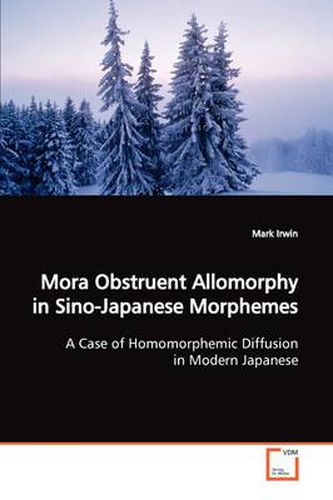Readings Newsletter
Become a Readings Member to make your shopping experience even easier.
Sign in or sign up for free!
You’re not far away from qualifying for FREE standard shipping within Australia
You’ve qualified for FREE standard shipping within Australia
The cart is loading…






This title is printed to order. This book may have been self-published. If so, we cannot guarantee the quality of the content. In the main most books will have gone through the editing process however some may not. We therefore suggest that you be aware of this before ordering this book. If in doubt check either the author or publisher’s details as we are unable to accept any returns unless they are faulty. Please contact us if you have any questions.
Modern Japanese exhibits apparently irregular allomorphic behaviour amongst a subset of bimoraic S[ino]-J[apanese] morphemes, those with a final mora in -/ki/, when appearing as the initial morpheme in a SJ bimorphemic compound whose second morpheme is /k/-initial. Detailed examination of synchronic and diachronic written corpora concludes that what is being witnessed is not irregularity as claimed in previous research, but homomorphemic diffusion, a process akin to lexical diffusion operating on a homomorphemic level. The independent status of homomorphemic diffusion is lent further weight by the phenomenon’s conforming to Bybee’s (2000, 2001, 2002) and Phillips’ (1998, 2001) theories that higher frequency lexemes (here homomorphs) tend to be affected earlier and more thoroughly in the case of reductive sound changes. When all the evidence here presented is examined, homomorphs appear to be behaving in lexical diffusionist terms just as individual lexemes or morphemes might be expected to.
$9.00 standard shipping within Australia
FREE standard shipping within Australia for orders over $100.00
Express & International shipping calculated at checkout
This title is printed to order. This book may have been self-published. If so, we cannot guarantee the quality of the content. In the main most books will have gone through the editing process however some may not. We therefore suggest that you be aware of this before ordering this book. If in doubt check either the author or publisher’s details as we are unable to accept any returns unless they are faulty. Please contact us if you have any questions.
Modern Japanese exhibits apparently irregular allomorphic behaviour amongst a subset of bimoraic S[ino]-J[apanese] morphemes, those with a final mora in -/ki/, when appearing as the initial morpheme in a SJ bimorphemic compound whose second morpheme is /k/-initial. Detailed examination of synchronic and diachronic written corpora concludes that what is being witnessed is not irregularity as claimed in previous research, but homomorphemic diffusion, a process akin to lexical diffusion operating on a homomorphemic level. The independent status of homomorphemic diffusion is lent further weight by the phenomenon’s conforming to Bybee’s (2000, 2001, 2002) and Phillips’ (1998, 2001) theories that higher frequency lexemes (here homomorphs) tend to be affected earlier and more thoroughly in the case of reductive sound changes. When all the evidence here presented is examined, homomorphs appear to be behaving in lexical diffusionist terms just as individual lexemes or morphemes might be expected to.